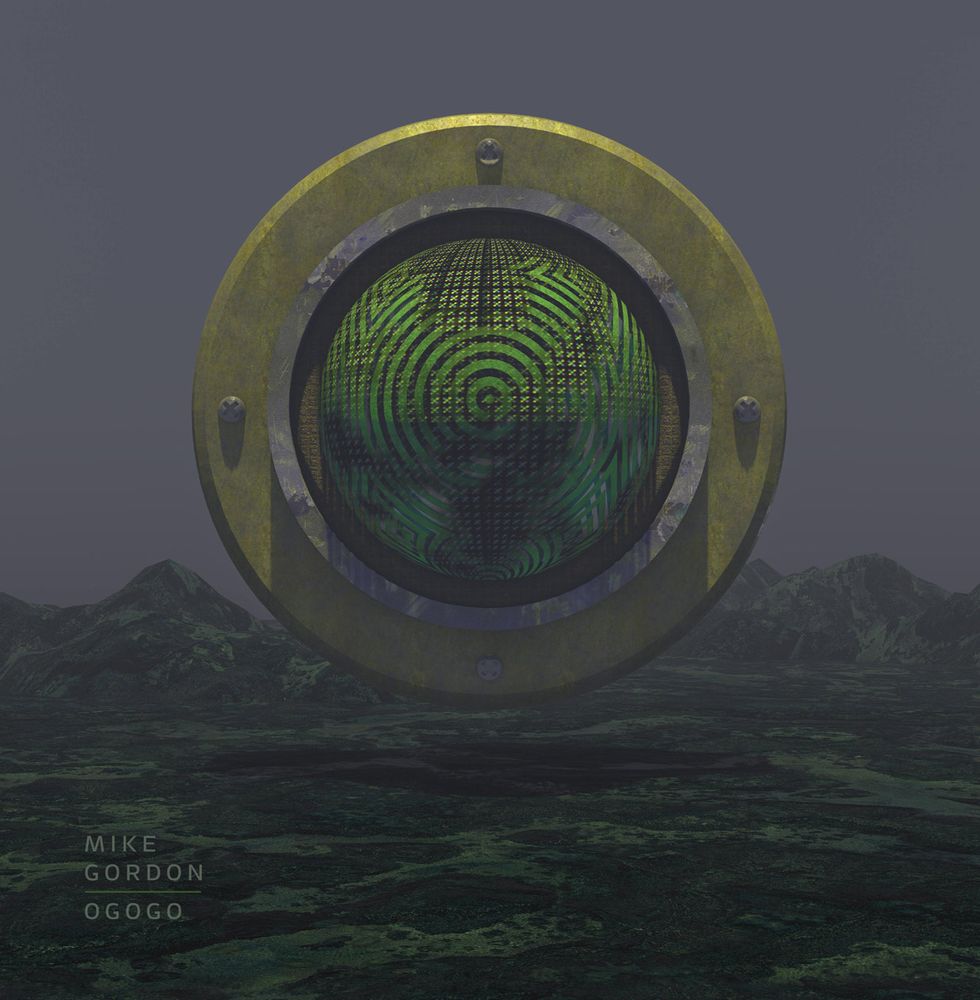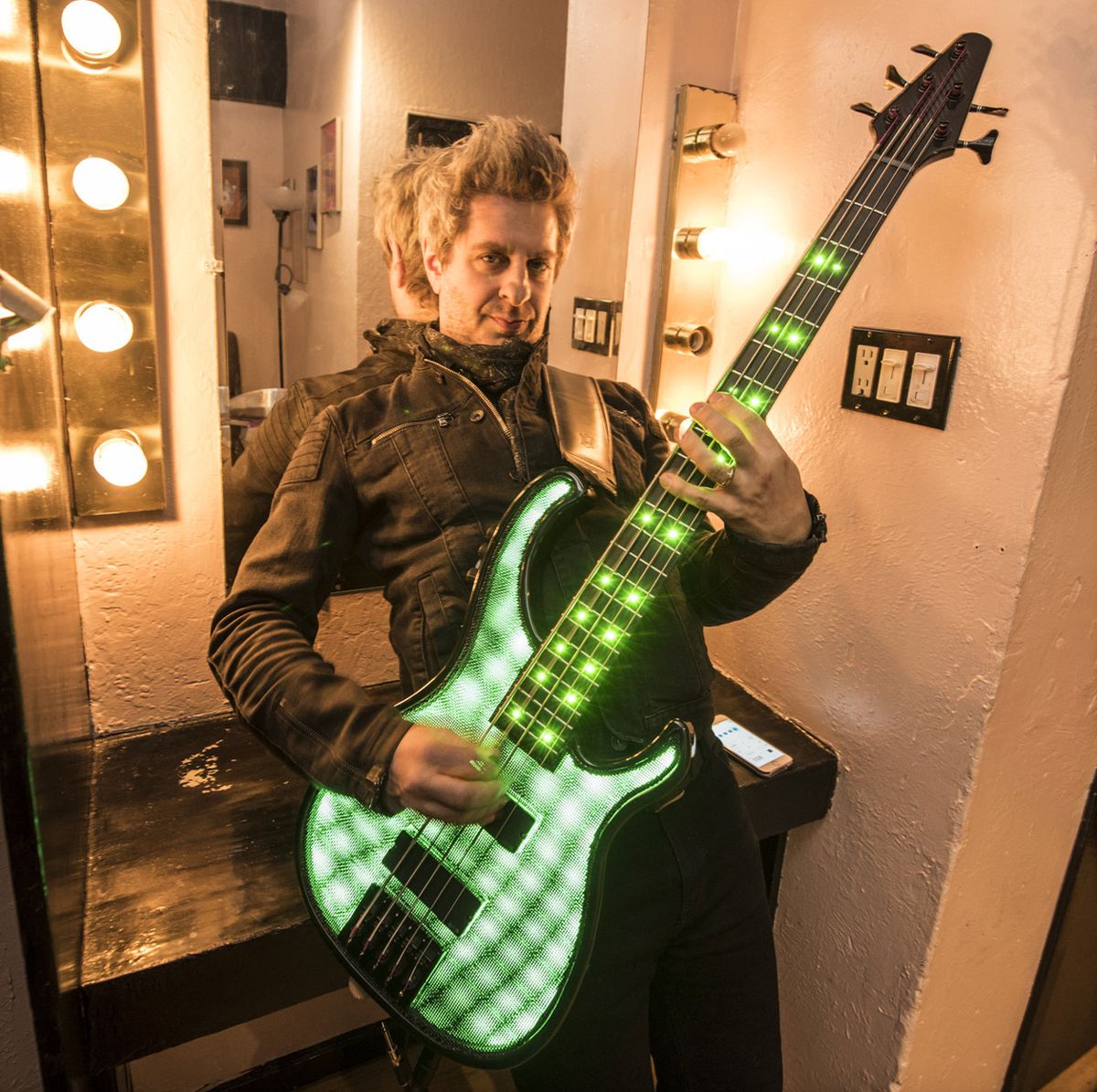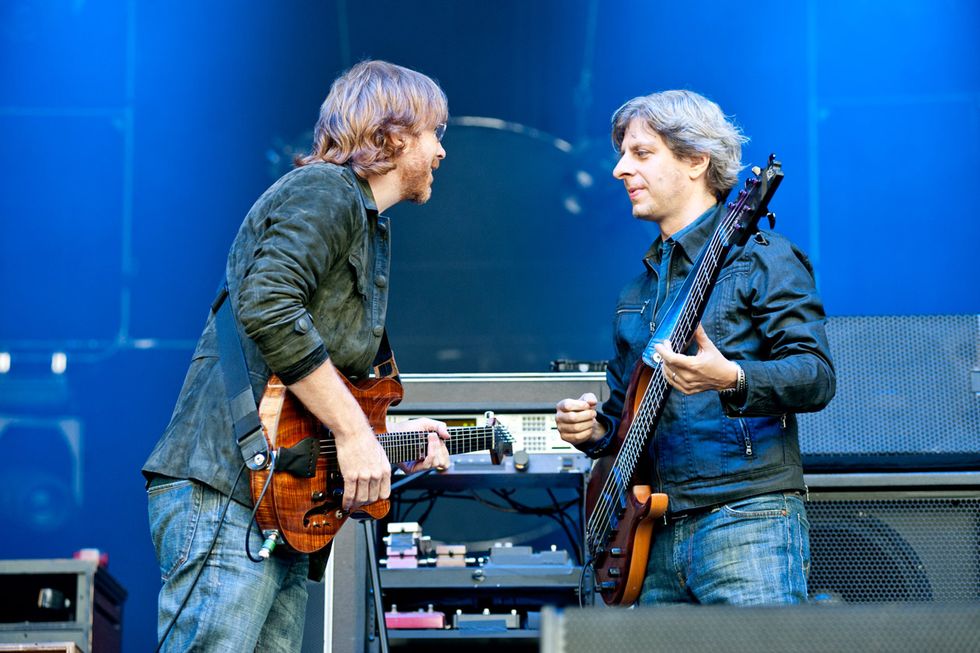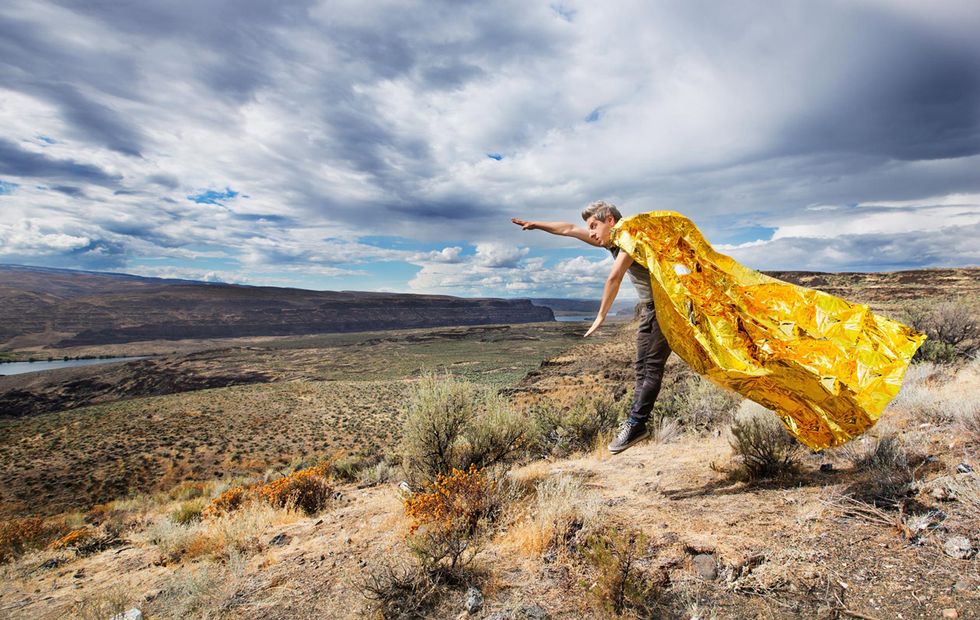On his fifth solo album, OGOGO, the Phish low-ender trips the light fantastic with flashy LED-equipped 5-strings and a newfound appreciation of pop simplicity.
Prior to recording his latest solo effort, OGOGO, Mike Gordon started letting his daughter, Tessa, do all the DJing in the car. For him, it was almost like a rite of passage, handing down a tradition that his folks let him indulge in as a child.
“I used to play all the ’70s rock stuff on the way to school,” he recalls. “And it was a long ride, because I went to a private Jewish school in Boston.” At first, he played Tessa all those ’70s tunes he now knows “inside-out” from those long rides. Then, he handed her the reins. “She goes on Spotify and plays pop stuff, and it’s not random,” he says with a glint of pride, alluding to the idea that his daughter may share his well-known methodical nature. “She was on a Maroon 5 kick for a while, but it was all female singer-songwriter stuff for four months.”
But what started out as a simple father-daughter activity had unexpected consequences for Gordon, who admits that some of the songs (and artists) have since become guilty pleasures. “I’m really appreciating the genius of people like Max Martin, who can so cleverly take a hook and let you ride on it,” he confesses. “Maybe it’s not a coincidence that the pop stuff came into my life. I’m enjoying it. It takes [songwriting] away from being too clever or too crafty with the arrangements.”
The real unexpected consequence of Tessa’s DJing, however, is that Gordon’s sentiment goes beyond pure enjoyment. The influence of the singer-songwriter pop aesthetic has seeped into OGOGO, where Gordon manages to infuse each tune with a melodic pop sensibility that often belies his day job in Phish, one of the world’s preeminent, and crafty, jam bands.
Pop-friendly and danceable, tunes like “Equilibrium” and “Steps” also evoke an element of ’80s new wave, demonstrating Gordon’s ability to translate all of his influences, old and new, into something uniquely his own. “Stealing Jamaica,” for example, recalls the magical reggae-pop mashups of the Police without ever sounding overly derivative. “We wanted to make OGOGO a little bit less rootsy and a little catchier at the same time,” he explains.
The “we” in that statement is his reference to guitarist Scott Murawski, his solo album songwriting partner for the last nine years. “We enjoy hooks that relentlessly float and hover, so, to push both ends of the spectrum between simpler and catchier and being more experimental—those were the goals.”
Growing up in Sudbury, Massachusetts, in the ’60s and ’70s, Gordon learned to play guitar, bass, and banjo as a child and has dabbled in fiction writing and documentary filmmaking throughout his life. He was an electrical engineering major at the University of Vermont when he met Trey Anastasio (guitar), Jon Fishman (drums) and Jeff Holdsworth (guitar— he left after graduation in 1986 and was replaced by Page McConnell on keyboards) and subsequently formed Phish. In addition to wrangling the low end for the world’s foremost jam band, he’s collaborated with a diverse array of artists, including Leo Kottke, Benevento/Russo Duo, Grappa Boom, SerialPod, and Ramble Dove to name but a few.
His documentary, Rising Low (2002) is based on the life and death of Gov’t Mule bassist Allen Woody and the making of a double-disc tribute album featuring a host of legendary bass players. It’s a must-watch for any bass aficionado. He released his first solo album, Inside In in 2003. OGOGO is his fifth solo album, and arguably his most masterfully constructed. As per usual for Gordon, his bass tone throughout the entirety of OGOGO is a carefully considered creation and master work that continues to earn him accolades by peers, fans, and critics alike.

OGOGO is Mike Gordon's fifth solo album. Gordon worked with his songwriting partner, guitarist Scott Murawski, and the album was produced by Shawn Everett, who recently engineered the War on Drugs' A Deeper Understanding, which won the 2017 Grammy for Best Rock Album.
Gordon and Murawski started writing for OGOGO a few years ago and enlisted Shawn Everett (Alabama Shakes, Weezer) to produce. The project developed more quickly than usual. “Our process became more streamlined and we were able to follow our gut feelings rather than questioning everything and trying a million different versions of things,” Gordon attests. “We were able to make decisions because the universe told us it’s got to be like this. So, here we are.”
PG caught up with Gordon while he was on tour in Kansas City, Missouri, with his solo band in support of OGOGO, which, in addition to Murawski, includes Robert Walter on B-3 organ and synth, drummer John Morgan Kimock, and percussionist Craig Myers.
How do you balance being a good shepherd for the creative process and imposing your will on a song or idea?
In the past, I’ve gotten in the way of that by questioning too much, so that’s been big for me lately—not questioning so much, just sort of saying, “If this gut feeling is good, then it must be right,” sooner in the process. There were songs on [2014’s] Overstep, like “Tiny Little World,” that had a thousand pages of ideas for lyric directions and experiments. Although, if you read about Leonard Cohen, that’s nothing. Every song took 10 years and he thought that was what you should do. So, it’s not that it’s wrong, it’s just that now we’re enjoying cutting to the chase.
Did you demo anything for OGOGO before tracking it?
Some songs we’d already recorded as demos and we used some of those tracks, but we always replaced the drums. Other ones we built up one instrument at a time, which I wanted to do some of, which I don’t usually do. And a bunch we recorded live, so it was all different varieties.
What’s the actual writing process like? Do you jam ideas live or share files back and forth?
Every song is different. Some songs came from live jams or jams in the studio, or maybe more specific experiments working with certain grooves. Often, we got together just the two of us to work with some melodies. The song “Steps,” for example, came from Scott’s stockpile of grooves and things he created himself. The chorus came from my daughter, who’s 8 years old, and the rest came from me. I feel like if something is resonating, I’m just going to grab it and run with it. Every different direction has been tried and used for this album.
Speaking of “Steps,” tell me about the bass solo. How’d that come about?
It was spontaneously created at the time of the demo. I never really needed there to be bass solos, especially in songs like that. Trey used to say, in a poppy, catchy song, a bass solo can just sink it. And I sort of agree, but with that we were making an early demo and I think I just suddenly played the whole thing exactly as it is today. It seemed justified because it’s so melodic and high up like that, and we harmonized it.
Gordon plays his Modulus TBX bass onstage with Trey Anastasio (left) in the legendary jam band, Phish. The pair met at Vermont University and formed Phish with drummer Jon Fishman and guitarist Jeff Holdsworth in 1983.
Photo by Lindsey Best
Surely, there are popular tunes with bass solos. “Brown Eyed Girl” and “All Right Now” quickly come to mind.
“Brown Eyed Girl” has a bass moment, but that’s not really a melody, that’s just a bass line, and “All Right Now” by Free is a bass line. I’m trying to think of an example of the bass going up to play a melody in a radio song. Maybe [Lou Reed’s] “Take a Walk on the Wild Side”—that’s like two basses. There are songs that the bass hook is so strong it might as well be the melody.
Did you have any kind of guiding principle regarding the direction of your bass parts on OGOGO?
Being willing to let the bass go away from time to time—having it not always in—has been another new thing. Leaving space for other things allows them to pop out.
Who were some of your early influences?
When I was around 5, my parents started playing Abbey Road a lot. Like a lot of people, everything started there for me. But the person who sold me my first bass had made a bass and an amp from a kit—he was my babysitter. He gave me [The Who’s] Quadrophenia with “The Real Me” on it. I also got into early Janis Joplin albums, like Big Brother and the Holding Company, and I would sit there and play along with the bass.
The ’60s and ’70s were an exciting time for bass players.
I just recently discovered the cassette tapes I used to make from the radio during high school. There are a million old songs on there from the beginning of the ’80s and the end of ’70s. I would learn bass lines and keyboard parts and guitar parts. I probably know 500 little radio hits from that era. It was all about John Entwistle, Paul McCartney, the Rolling Stones, the Allman Brothers, the Grateful Dead, Little Feat, Lynyrd Skynyrd, Led Zeppelin, Aerosmith—I was just learning all that stuff.
I hear some of the Grateful Dead’s Phil Lesh in your playing, as well.
For me, there’s no one like Phil Lesh. I’m just a huge fan. In terms of being able to create a sound, a tone, a groove, and a melodic sense that’s free and varying and yet, always very powerful with propulsion—I’ve never seen that combination to that degree before, so he ends up being an enormous influence.
Do you have any formal education in music?
Here’s my brief silly history. I was already taking guitar lessons at Sudbury Music Center in Massachusetts when I joined the jazz band in high school and we got a guest conductor from the Harvard jazz band for the last semester of high school—he was amazing. He called up Jim Stinnett to teach bass and he became my mentor. He still teaches at Berklee. I would go to him and it was like life-changing lessons about getting to the fundamentals and practicing every day and not practicing what you practiced yesterday, but turning over a new leaf every day. Practice always had to consist of three things: technique, new concepts, and then actual playing. And then also listening—so three-and-a-half parts.
You’re strictly using a pick these days?
I had been fingerstyle for many years. I already was a huge fan of Phil Lesh and his tone, but then I started to experience a couple of other people in different kinds of music where the guys used a pick, like the guy from the Doobie Brothers [Tiran Porter], and a few ska bands. It’s something about the muting with the palm that makes for a different groove. I really enjoy the way that works with the music. I don’t know if Geddy Lee uses a pick with that trebly sound [Author’s note: Lee doesn’t use a pick] and Chris Squire [Author’s note: Squire did use a pick], but I like a darker, warmer pick sound, if there is such a thing.

Basses
Visionary Instruments Moiré M1 and M2 5-strings with EMG 35DC pickups
Amps
Eden WT800B
Ampeg SVT-410HEN
Meyer Sound CP-10 Parametric EQ
Meyer Sound powered speaker system (two 750P 2x18 cabs and two UPA-1Ps with 12" low frequency drivers and 3" compression drivers)
Effects
ADA MB-1 preamp
Akai Deep Impact SB1 Bass Synthesizer
Boss SYB-3 Bass Synthesizer
Boss BF-2 Flanger
Boss GE-7 Graphic EQ
EBS OctaBass
Electro-Harmonix Bass Micro Synthesizer
Electro-Harmonix Superego Synth Engine
Eventide Eclipse V4 processor
Eventide Space reverb
Eventide DSP4500 Ultra-Harmonizer
Ibanez FL9 Flanger
Lexicon LXP-15 Multi-Effects Processor
MXR M109 EQ
Lovetone The Meatball envelope filter
Source Audio Soundblox Bass Envelope Filter
Source Audio Soundblox Multiwave Bass Distortion
Strings and Picks
Ken Smith Slick Round Series (.044-.130)
Dunlop 1.5 mm
Is it the attack that appeals to you?
I don’t need a strong attack—I just don’t like it to sound like fingers. I like it to sound distinctively different. Part of it is the muting, it’s not just the attack. With fingers, there’s something that’s nice about touching the strings a lot—something intimate about that. But I’m just enjoying the chunkier sound of the pick. It’s chunkier rhythmically because, with the muting, each note becomes a different sort of chunk. And it’s chunkier musically and sonically because the attack and the release are so defined. On rare occasions I use my fingers, especially in the studio.
What’s your pick of choice?
It’s a triangular Dunlop—very firm and very thin. I don’t like them on guitar strings because they’re so thin and firm that it ends up sounding plinky, but on the bass, it gives you a more specific attack, especially with slightly flatter strings.
What do you mean “flatter” strings?
I use Ken Smith semi-flats. I really got used to them. There’s something about the flatter sound with a pick that makes it less grungy. I like to get away from the grungy sound of the roundwounds.
I understand you invented your main bass?
I wasn’t the designer or builder, but I came up with the concept. It was designed and built by Ben Lewry of Visionary Instruments. The concept is that there are two screens—like screen doors—and LED lights on the inside that make what’s known as a moiré pattern. It looks 3-D, like a pool of water. The body is hollow and so all the gadgetry on the inside has to be moved out of the way of the lights.
There are all these different settings too, where, if I play a note, the lights come on or if I go up the neck, the color changes. But most useful is its wireless DMX [a digital communication network] to the light board. So, with my band—I don’t use it with Phish at all—we have set pieces that match these moiré patterns. I have a wireless send for the audio and then I have wireless communication coming in from the light board, so our lighting guy can create all these distinct colors. Scott has the same thing, so the sets and guitars can match with signals from afar.
Did you use the Visionary Instruments Moiré bass on the entire record?
On “Steps” I ended up using a Fender Precision that the studio had that I really liked, but I used a newer Moiré on the rest of the album. The second version is the M2 or Moiré 2. I started really liking the tone. I have a bunch of basses, but it was my favorite tone. Partly because I play it a lot and partly because I use a Modulus bass with Phish and the Moiré is a similar shape and uses the same EMG pickups.
I imagine the hollow body and screens influence the instrument’s tone.
Yes, because it’s hollowed out, there’s some room for natural resonance, and those metal screens vibrate a little bit, so there’s a natural resonance that makes it organic sounding.
The Moiré is a 5-string?
Nowadays it’s always 5-string. It’s not just to get the lowest notes, because I don’t usually use the lowest notes. It’s kind of another Phil Lesh thing—to play in the middle of the neck for a consistent sound. It really allows you to dial in your tone. Instead of playing an F# on the E string as you would do on a 4-string bass, I play it on the 7th fret of the B string. And then it takes dialing in your sound so it’s not too boomy. The B string sometimes lacks the attack, but when all is working correctly, it’s a pretty fun way to go and you can keep your hand in the same position.
Mike Gordon has been playing with Phish since 1983. But his musical muse on his latest solo album, OGOGO, was his 8-year-old daughter, Tessa, who introduces him to melodic pop songs via Spotify when they're riding in the car.
Photo by René Huemer
What rig did you record with?
On the road, I’ve always used Meyer Sound stuff. It’s a Phil Lesh-inspired rig, but in the studio, I’ve always used Eden stuff. My last three albums I’ve been involved with, it’s all these little Eden 10" speakers. This time I wanted to switch to Ampeg cabs because I had a few positive experiences in other studios playing other people’s rigs. I tried out a few and found one I loved. I think it’s a SVT-410HEN. It’s from before they started being made in Vietnam—maybe around 2001.
So it was just the Ampeg cab?
Yeah, I still love the Eden WT800B [head]. They’re so hard to get now. The WT800A and WT800C don’t sound anything like it. It’s only the 800B. It’s chunkier and the midrange has this nice presence. It has a sweepable, semi-parametric EQ on three different midrange areas—that’s hard to come by. Mostly you get a limited version of that. Often, you click from frequency to frequency or you only have one band. I find it’s important because I like to make the notes on the neck sound even.
How are you making the notes more even?
Say the D on the A string in the middle of the neck is much softer than the other notes, I just fill it in 73 Hz or 88 Hz. Or if the A on the E string is much too loud then I turn it down—it always pays off. Sometimes I like it to be uneven. I’ll play a G and it’ll resonate and wallow in a really nice way and I’ll just enjoy it, but by the end of the night, I’m always happier if I balance it out and let it be all even.
Your producer, Shawn Everett, is known for being very experimental in the studio. What did he bring to the table?
When I first met Shawn, he was doing three albums. One of them was Broken Social Scene and we were talking about recording bass and he said, “Well, I just worked with Broken Social Scene and they said, ‘Mike Gordon has the best bass sound on the planet, so whatever you do, don’t fuck with it.’” I appreciate that sentiment, but I’m willing to fuck with it. In the end, we probably got more experimental with the other instruments, but every instrument and every voice were recorded in ways I’ve never seen before.
Can you give us an example?
He wanted to add reverb to a bunch of the bass and have it distantly miked and I appreciated the idea, but I didn’t really like it, so we didn’t do that. I honestly don’t know everything that happened. I do know that I like to avoid too much compression. Some is good to get it to pump, but there were times when I said, “You know, this is a really great bass sound and it just seems a little puffy now—a little pillowy.” And he said, “Oh, I know what it is. I added this extra compressor. I’ll turn it off.” Then it came back to how I like it.
Compression seems to be a polarizing issue, particularly for bass players.
There is a tendency to overuse compression, in my opinion. It’s helpful for producers that just want to hear the vocal and not hear the bass and have it be squashed, so you end up feeling it more than hearing it. Some people want that sound. Sometimes I even like that sound, but usually I’d rather it be more dynamic and have a bit of an attack and be somewhat consistent. It has to breathe for me to like it.
You handle a lot of the singing on your solo records. What’s that process been like for you?
When Phish broke up in 2004—that was for four years—I suddenly realized I had to write a whole repertoire. Not just an album, but I had to do it all on my own and I was really loving that, to the point where, when we got back together I had to see whether I wanted that because I was really enjoying carving my own path.
As someone who’s been in the jam-band world for so long, you seem to have a knack for knowing what it takes to craft a simple song.
I have a friend, Madi Diaz, who writes and sings poppy songs. She just released an EP and I enjoy how simple and cathartic it is to listen to music that’s just so endearing in a simple, pure way. I’m not throwing away all my older influences. I still like funky grooves and having them go into the ether for minutes on end. When the music starts to play itself, it’s a magical feeling. But to have a simple song—I’m just putting it on a pedestal these days.
These simple melodies you’re referring to can happen in a jam, too, can’t they?
If Phish is in a 20-minute jam, the best parts aren’t noodly at all—we’ll get onto a melody and just float with it. There usually isn’t even a lyric and we usually let it repeat, or at least I find that when we let it repeat, those are some of the most religious experiences, where we’re just taking a pattern and letting it flow and we’re riding on it like you ride on a merry-go-round. The melody just floats you on top of the rhythm.
Your songs have a very intimate, personal charm to them. Is that intentional?
I was reading Leonard Cohen’s book of all the interviews he ever gave [Leonard Cohen on Leonard Cohen: Interviews and Encounters], and he talks a lot about honesty and how singers should sing something they’ve lived on some level. It can be a metaphor or a character or something, but Scott and I wanted to make sure that we were reflecting upon some things we think about. And so, the two issues that kept coming up were balancing acts and teeter-tottering back and forth between sanity and insanity.
How does that make the lyrical content more personal?
There’s a Leonard Cohen quote where he talks about wanting the song to not just be a cry, which would be like, “Oh, I love her, and she’s gone.” He wants the song to get honest by going deeper into that experience and ask, “Okay, what’s really going on here? Well, I never really loved her, it was just the idea of her, which was really just something within myself, which is really just my own lustfulness …” or whatever the subtle nuances are. It’s tricky, but it’s cool to try to be a little more authentic on some level—it’s the making of any good songwriter.
Check out this 2015 hook- and groove-laden performance by the Mike Gordon Band in its entirety.



